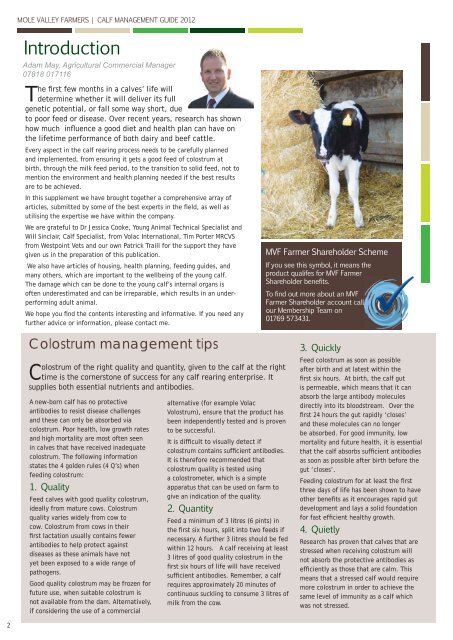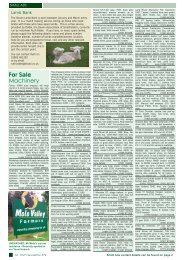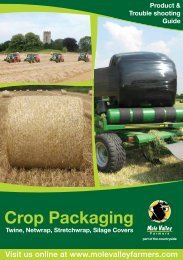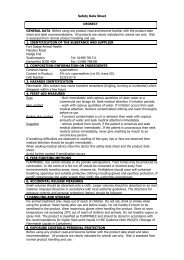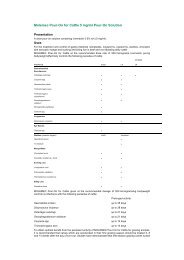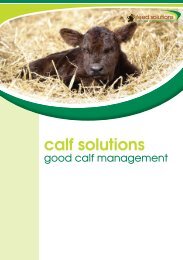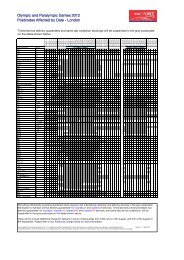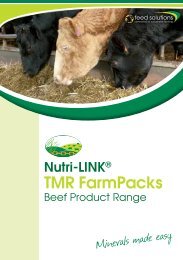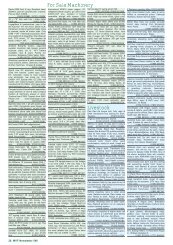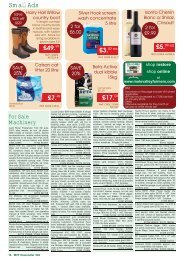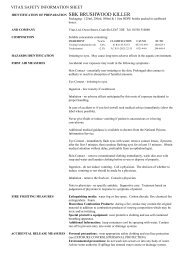MoleValley Calf - Mole Valley Farmers
MoleValley Calf - Mole Valley Farmers
MoleValley Calf - Mole Valley Farmers
You also want an ePaper? Increase the reach of your titles
YUMPU automatically turns print PDFs into web optimized ePapers that Google loves.
2<br />
MOLE VALLEY FARMERS | CALF MANAGEMENT GUIDE 2012<br />
Introduction<br />
Adam May, Agricultural Commercial Manager<br />
07818 017116<br />
The fi rst few months in a calves’ life will<br />
determine whether it will deliver its full<br />
genetic potential, or fall some way short, due<br />
to poor feed or disease. Over recent years, research has shown<br />
how much infl uence a good diet and health plan can have on<br />
the lifetime performance of both dairy and beef cattle.<br />
Every aspect in the calf rearing process needs to be carefully planned<br />
and implemented, from ensuring it gets a good feed of colostrum at<br />
birth, through the milk feed period, to the transition to solid feed, not to<br />
mention the environment and health planning needed if the best results<br />
are to be achieved.<br />
In this supplement we have brought together a comprehensive array of<br />
articles, submitted by some of the best experts in the fi eld, as well as<br />
utilising the expertise we have within the company.<br />
We are grateful to Dr Jessica Cooke, Young Animal Technical Specialist and<br />
Will Sinclair, <strong>Calf</strong> Specialist, from Volac International, Tim Porter MRCVS<br />
from Westpoint Vets and our own Patrick Traill for the support they have<br />
given us in the preparation of this publication.<br />
We also have articles of housing, health planning, feeding guides, and<br />
many others, which are important to the wellbeing of the young calf.<br />
The damage which can be done to the young calf’s internal organs is<br />
often underestimated and can be irreparable, which results in an underperforming<br />
adult animal.<br />
We hope you fi nd the contents interesting and informative. If you need any<br />
further advice or information, please contact me.<br />
Colostrum management tips<br />
Colostrum of the right quality and quantity, given to the calf at the right<br />
time is the cornerstone of success for any calf rearing enterprise. It<br />
supplies both essential nutrients and antibodies.<br />
A new-born calf has no protective<br />
antibodies to resist disease challenges<br />
and these can only be absorbed via<br />
colostrum. Poor health, low growth rates<br />
and high mortality are most often seen<br />
in calves that have received inadequate<br />
colostrum. The following information<br />
states the 4 golden rules (4 Q’s) when<br />
feeding colostrum:<br />
1. Quality<br />
Feed calves with good quality colostrum,<br />
ideally from mature cows. Colostrum<br />
quality varies widely from cow to<br />
cow. Colostrum from cows in their<br />
fi rst lactation usually contains fewer<br />
antibodies to help protect against<br />
diseases as these animals have not<br />
yet been exposed to a wide range of<br />
pathogens.<br />
Good quality colostrum may be frozen for<br />
future use, when suitable colostrum is<br />
not available from the dam. Alternatively,<br />
if considering the use of a commercial<br />
alternative (for example Volac<br />
Volostrum), ensure that the product has<br />
been independently tested and is proven<br />
to be successful.<br />
It is diffi cult to visually detect if<br />
colostrum contains suffi cient antibodies.<br />
It is therefore recommended that<br />
colostrum quality is tested using<br />
a colostrometer, which is a simple<br />
apparatus that can be used on farm to<br />
give an indication of the quality.<br />
2. Quantity<br />
Feed a minimum of 3 litres (6 pints) in<br />
the fi rst six hours, split into two feeds if<br />
necessary. A further 3 litres should be fed<br />
within 12 hours. A calf receiving at least<br />
3 litres of good quality colostrum in the<br />
fi rst six hours of life will have received<br />
suffi cient antibodies. Remember, a calf<br />
requires approximately 20 minutes of<br />
continuous suckling to consume 3 litres of<br />
milk from the cow.<br />
MVF Farmer Shareholder Scheme<br />
If you see this symbol, it means the<br />
product qualifes for MVF Farmer<br />
Shareholder benefits.<br />
To find out more about an MVF<br />
Farmer Shareholder account call<br />
our Membership Team on<br />
01769 573431.<br />
3. Quickly<br />
Feed colostrum as soon as possible<br />
after birth and at latest within the<br />
fi rst six hours. At birth, the calf gut<br />
is permeable, which means that it can<br />
absorb the large antibody molecules<br />
directly into its bloodstream. Over the<br />
fi rst 24 hours the gut rapidly ‘closes’<br />
and these molecules can no longer<br />
be absorbed. For good immunity, low<br />
mortality and future health, it is essential<br />
that the calf absorbs suffi cient antibodies<br />
as soon as possible after birth before the<br />
gut ‘closes’.<br />
Feeding colostrum for at least the fi rst<br />
three days of life has been shown to have<br />
other benefi ts as it encourages rapid gut<br />
development and lays a solid foundation<br />
for fast effi cient healthy growth.<br />
4. Quietly<br />
Research has proven that calves that are<br />
stressed when receiving colostrum will<br />
not absorb the protective antibodies as<br />
effi ciently as those that are calm. This<br />
means that a stressed calf would require<br />
more colostrum in order to achieve the<br />
same level of immunity as a calf which<br />
was not stressed.


